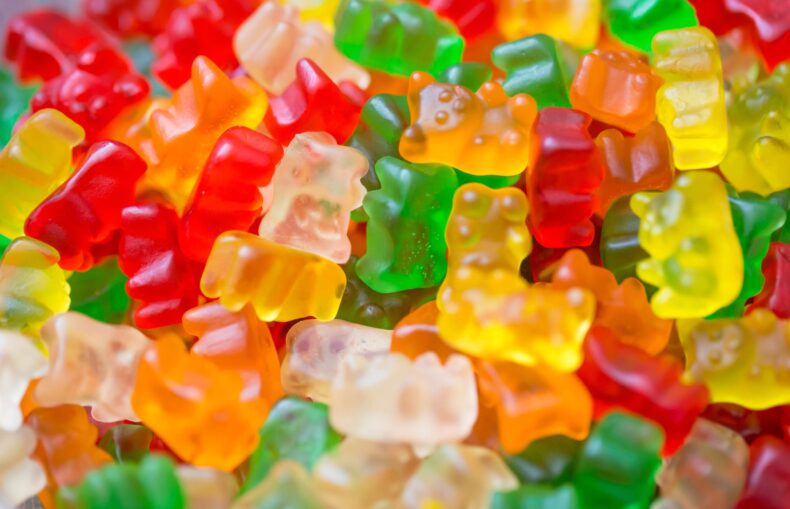The holidays are a time for family, food, and fun—but let’s be real, they can…
Candy and kids can be a bit of a hot topic for many parents. As a pediatric dietitian, I often hear concerns like, “Will candy make my child hyperactive?” or “Shouldn’t they eat something healthy before they get a treat?” These worries stem from common myths that can actually create more stress around candy than needed.
I’m here to help you untangle three of the most common candy myths I hear—especially when it comes to Halloween candy—so that you can feel more relaxed about how sweets fit into your child’s diet.
Myth 1: Candy Causes Hyperactivity
It’s a common belief that sugar sends kids bouncing off the walls, but here’s the truth: research doesn’t support the idea that candy—or sugar in general—causes hyperactivity. A landmark study (plus many more) explored this myth, and the results show no direct link between sugar intake and kids’ behaviour.
So, why does it seem like kids get more hyper when they have sweets? Often, it’s the environment that’s at play. Celebrations, like birthday parties, holidays, and Halloween, where candy and excitement are all around, naturally lead to higher energy levels.
Does this mean we need to cut out sweets on Halloween or other special occasions? Absolutely not. In fact, when we step back from worrying about sugar, we create more space for balance—and less pressure—around all foods. This brings us to another common strategy that might seem like a good idea at first glance but could do more harm than good: the Switch Witch. Let’s dive into why this approach might not be as helpful as we think.
Myth 2: The Switch Witch is the Best Strategy
The Switch Witch has become a popular post-Halloween tradition where kids trade their candy for a toy or non-food item. The idea behind it is to reduce the amount of candy kids consume while giving them something they might enjoy even more. On the surface, it seems like a win-win—less sugar, more fun, right?
But there are a few “catches”: strategies like this can unintentionally send the message that candy is “bad” and “off limits”, which is not really what we want to do. It can place candy on a pedestal, making it even more desirable to kids…what I call the “forbidden fruit effect”. In other words, the Switch Witch concept can unintentionally create the idea that candy is something to be avoided or feared. Some kids might also feel upset or disappointed at having to give up their candy (even secretly), especially if they were excited about specific treats. This could lead to feelings of deprivation or resentment, even if they get a toy or gift in return.
So, instead of inviting the Switch Witch into your home, my advice is to foster a food-neutral home—one where there’s no moral judgment attached to any food (candy included!). This helps take away the excitement and pressure around candy, so kids can tune in to their bodies and better self-regulate. With that in mind, let’s tackle the next common myth: the idea that kids should eat “healthy” food before treats.
Myth 3: Kids Should Eat “Healthy Food” Before Treats
It’s easy to see why this strategy might seem appealing—encouraging your child to eat their veggies first and only then allowing them a treat, feels like a good strategy to ensure your child is getting the “nutritious stuff” first. If they fill up on healthy stuff, there won’t be much more room for treats, right?! Well… not exactly.
What your child interprets may be “Oh, I guess I have to ‘earn’ my Halloween stash by eating my ‘healthy’ food first”. Suddenly, candy becomes the ultimate reward, and things like fruits and veggies feel like an obligation. Yup, as a dietitian, I have seen this well-intentioned strategy backfire countless times. And the fact of the matter is, no matter how much they “fill up” on nutritious foods first, you better believe they’ll make room for their candy, which may actually translate into overeating and feeling uncomfortable.
So what’s the solution? A mindset shift. Halloween is actually an opportunity for kids to build a positive relationship with food. Candy, like any food, doesn’t need to be earned—it can be enjoyed alongside other foods. One way to reduce the pressure and novelty around sweets is to offer candy as part of a snack or meal (or even beforehand), rather than dangling it as a reward after the meal. This helps normalize candy and takes away the “forbidden fruit” factor. It might feel counterintuitive at first, but over time, it teaches kids that all foods have a place at the table so to speak, without assigning moral value to any of them.
My Favourite Candy Options from Spud!
This dietitian enjoys candy just as much as the next person! When it comes to candy, I love choosing options that are friendly for different dietary needs. Whether you’re looking for gluten-free, dairy-free, or nut-free treats, Spud has plenty of great options that you can feel good about giving to your kids this Halloween. Here are some of my (and my kids’) faves!
So there you have it! Three common candy myths, busted. At the end of the day, candy can absolutely be part of a balanced approach to food. When we allow sweets to be just another food option, we help our kids develop a healthier, more relaxed relationship with food. By fostering an environment where candy isn’t forbidden or overly restricted, we give our children the tools to trust their bodies and regulate their intake with time.






